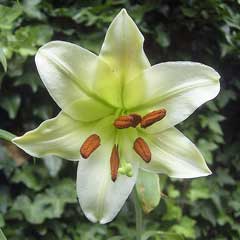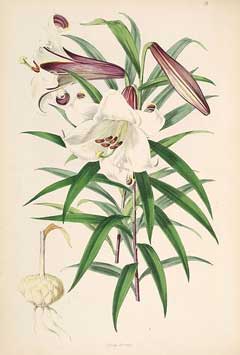 |
|
http://commons.wikimedia.org/wiki/User:Denis_Barthel |
 |
| http://commons.wikimedia.org/wiki/File:Lilium_brownii.jpg |
Translate this page:
Summary
Physical Characteristics

 Lilium brownii is a BULB growing to 1.2 m (4ft).
Lilium brownii is a BULB growing to 1.2 m (4ft).
See above for USDA hardiness. It is hardy to UK zone 5. It is in flower in July. The species is hermaphrodite (has both male and female organs) and is pollinated by Bees.
Suitable for: light (sandy) and medium (loamy) soils and prefers well-drained soil. Suitable pH: mildly acid, neutral and basic (mildly alkaline) soils. It can grow in semi-shade (light woodland) or no shade. It prefers moist soil.
UK Hardiness Map
US Hardiness Map
Synonyms
L. candidum. non L. L. odorum.
Plant Habitats
Woodland Garden Sunny Edge; Dappled Shade; Shady Edge;
Edible Uses
Edible Parts: Flowers Root
Edible Uses: Condiment
Bulb - cooked[61, 105, 163]. A pleasant slightly sweet taste[183], they are used as a vegetable in much the same way as potatoes (Solanum tuberosum). A starch can be extracted from the bulbs and added to other foods[183]. The grated bulb can be added as a thickener to soups etc[183]. The bulb is usually rather small[260] - it is 25 - 40mm in diameter[266]. The dried flower petals are used as a flavouring in soups[183].
References More on Edible Uses
Medicinal Uses
Plants For A Future can not take any responsibility for any adverse effects from the use of plants. Always seek advice from a professional before using a plant medicinally.
Antitussive Carminative Diuretic Expectorant Febrifuge Pectoral Poultice Sedative
Tonic
The bulb is antitussive, diuretic, carminative, expectorant, febrifuge, pectoral, sedative and tonic[147, 176, 218]. A decoction is used in the treatment of coughs and haematemesis due to deficiency condition, anxiety, apprehension, oedema and difficult urination[147]. Bulbils from the leaf axils are used in the treatment of intestinal disorders[218]. The dried and powdered flowers are used as a poultice for bruises, cuts etc[218].
References More on Medicinal Uses
The Bookshop: Edible Plant Books
Our Latest books on Perennial Plants For Food Forests and Permaculture Gardens in paperback or digital formats.

Edible Tropical Plants
Food Forest Plants for Hotter Conditions: 250+ Plants For Tropical Food Forests & Permaculture Gardens.
More

Edible Temperate Plants
Plants for Your Food Forest: 500 Plants for Temperate Food Forests & Permaculture Gardens.
More

More Books
PFAF have eight books available in paperback and digital formats. Browse the shop for more information.
Shop Now
Other Uses
References More on Other Uses
Cultivation details
Prefers an open free-draining humus-rich loamy soil with its roots in the shade and its head in the sun[200]. Requires a light soil[42, 47]. Is this species lime-tolerant?[200]. Plants prefer a position that s moist in the summer but dry in the winter[260]. Stem rooting, the bulbs should be planted 20 - 25cm deep[42, 47, 143]. Said to be very difficult in cultivation[47], this species tolerates temperatures down to about -3°c[260]. It grows well at Kew but is not hardy everywhere[143]. Self-sterile, the type species does not set seed[47]. It is believed that this species is either of hybrid origin or it is a garden form of the true wild species L. brownii colchesteri. Wils.[143]. It is the sub-species colchesteri that is used medicinally[176, 218]. The flowers have a soft sweet fragrance. This fragrance is more pronounced in the variety 'Viridulum'[245]. The plant does not come into growth until late spring[260]. It should be protected against slugs at this time since if the shoot tip is eaten out the bulb will not grow in that year and will lose vigour[200]. The edible bulbs are occasionally sold in ethnic markets in San Francisco[183] and are a common food item in China[179], where the plant is cultivated for edible and medicinal use[266]. For polyculture design as well as the above-ground architecture (form - tree, shrub etc. and size shown above) information on the habit and root pattern is also useful and given here if available. The plant growth habit is a clumper with limited spread [1-2]. The root pattern is a bulb.
References Carbon Farming Information and Carbon Sequestration Information
Temperature Converter
Type a value in the Celsius field to convert the value to Fahrenheit:
Fahrenheit:
The PFAF Bookshop
Plants For A Future have a number of books available in paperback and digital form. Book titles include Edible Plants, Edible Perennials, Edible Trees,Edible Shrubs, Woodland Gardening, and Temperate Food Forest Plants. Our new book is Food Forest Plants For Hotter Conditions (Tropical and Sub-Tropical).
Shop Now
Plant Propagation
Seed - immediate epigeal germination[130]. Sow thinly in pots from late winter to early spring in a cold frame. Should germinate in 2 - 4 weeks[163]. Great care should be taken in pricking out the young seedlings, many people prefer to leave them in the seed pot until they die down at the end of their second years growth. This necessitates sowing the seed thinly and using a reasonably fertile sowing medium. The plants will also require regular feeding when in growth. Divide the young bulbs when they are dormant, putting 2 - 3 in each pot, and grow them on for at least another year before planting them out into their permanent positions when the plants are dormant[K]. Division with care in the autumn once the leaves have died down. Replant immediately[200]. Bulb scales can be removed from the bulbs in early autumn. If they are kept in a warm dark place in a bag of moist peat, they will produce bulblets. These bulblets can be potted up and grown on in the greenhouse until they are large enough to plant out[200]. Bulblets are formed on the stem just below the soil surface. These should be dug up in the autumn and replanted immediately, preferably in a cold frame for growing on until large enough to plant out into the garden[143, 163].
Other Names
If available other names are mentioned here
Native Range
TEMPERATE ASIA: Anhui Sheng, Fujian Sheng, Gansu Sheng, Guangdong Sheng, Guangxi Zhuangzu Zizhiqu, Guizhou Sheng, Hebei Sheng, Henan Sheng, Hong Kong, Hubei Sheng, Hunan Sheng, Jiangsu Sheng, Jiangxi Sheng, Shaanxi Sheng, Shanxi Sheng, Sichuan Sheng, Yunnan Sheng, Zhejiang Sheng,China. TROPICAL ASIA: Myanmar,
Weed Potential
Right plant wrong place. We are currently updating this section.
Please note that a plant may be invasive in one area but may not in your area so it's worth checking.
Conservation Status
IUCN Red List of Threatened Plants Status :

Growth: S = slow M = medium F = fast. Soil: L = light (sandy) M = medium H = heavy (clay). pH: A = acid N = neutral B = basic (alkaline). Shade: F = full shade S = semi-shade N = no shade. Moisture: D = dry M = Moist We = wet Wa = water.
Now available:
Food Forest Plants for Mediterranean Conditions
350+ Perennial Plants For Mediterranean and Drier Food Forests and Permaculture Gardens.
[Paperback and eBook]
This is the third in Plants For A Future's series of plant guides for food forests tailored to
specific climate zones. Following volumes on temperate and tropical ecosystems, this book focuses
on species suited to Mediterranean conditions—regions with hot, dry summers and cool, wet winters,
often facing the added challenge of climate change.
Read More
Expert comment
Author
F.E.Br. ex Meillez.
Botanical References
200266
Links / References
For a list of references used on this page please go here
Readers comment
| Add a comment |
|
If you have important information about this plant that may help other users please add a comment or link below. Only comments or links that are felt to be directly relevant to a plant will be included. If you think a comment/link or information contained on this page is inaccurate or misleading we would welcome your feedback at [email protected]. If you have questions about a plant please use the Forum on this website as we do not have the resources to answer questions ourselves.
* Please note: the comments by website users are not necessarily those held by PFAF and may give misleading or inaccurate information.
To leave a comment please Register or login here All comments need to be approved so will not appear immediately.
|
|